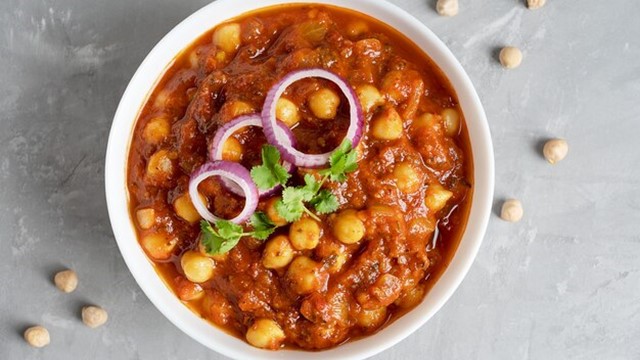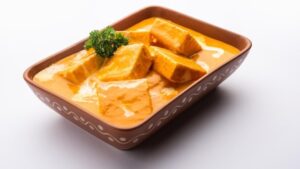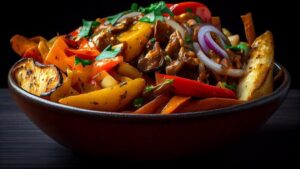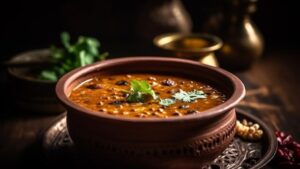Chana Masala is a beloved and flavorful dish from Indian cuisine that features chickpeas (also known as garbanzo beans) simmered in a rich and aromatic tomato-based gravy infused with a blend of spices. This dish, popularly known as “Chole” in some regions of India, holds a special place in Indian households and is widely enjoyed across the globe for its robust flavors and cultural significance.
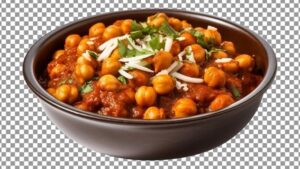
Key Components:
Chickpeas (Garbanzo Beans):
- The primary ingredient of Chana Masala is chickpeas, which are soaked, cooked until tender, and then used as the base of the dish. Chickpeas bring a nutty flavor and a satisfying texture to the dish.
Aromatic Spices and Aromatics:
- Chana Masala derives its distinctive taste from a blend of aromatic spices such as cumin, coriander, turmeric, garam masala, cloves, cinnamon, and sometimes dried mango powder (amchur). Onions, tomatoes, ginger, and garlic are sautéed to create a flavorful base for the gravy.
Tomato-Based Gravy:
- The gravy is prepared by simmering onions, tomatoes, and spices until they form a thick and flavorful base. This base infuses the cooked chickpeas with its rich and tangy essence.
Culinary Evolution
The culinary evolution of Chana Masala reflects a journey spanning centuries, marked by influences from regional traditions, cultural exchanges, and the creative adaptations within Indian cuisine.
Historical Origins:
Chana Masala’s roots can be traced back to ancient India, where chickpeas were a staple part of the diet due to their nutritional value and availability. The use of spices like cumin, coriander, and turmeric dates back to centuries-old culinary practices within the Indian subcontinent.
Regional Variations:
Over time, Chana Masala evolved differently across various regions of India, influenced by local ingredients, cooking techniques, and cultural nuances. For instance:
- In Punjab, it’s known as “Chole” and often includes anardana (dried pomegranate seeds) for a tangy flavor.
- In the southern regions, variations might incorporate coconut or curry leaves for a distinct taste.
- East Indian renditions might feature mustard oil or other regional spices.
Culinary Adaptations:
The evolution of Chana Masala extends beyond geographical boundaries. As Indian cuisine gained popularity worldwide, Chana Masala underwent adaptations to suit global palates and incorporate locally available ingredients. This led to fusion variations and creative interpretations in different countries, reflecting a fusion of cultures and tastes.
Fusion Cuisine:
In modern culinary landscapes, Chana Masala has become a symbol of fusion cuisine. Chefs and home cooks experiment with diverse ingredients, blending international flavors or incorporating innovative twists to the traditional recipe. These adaptations showcase the dish’s versatility while celebrating its cultural roots.
Health and Dietary Trends:
In recent years, Chana Masala has gained recognition for its nutritional value, especially as a protein-rich and vegetarian-friendly option. This aligns with the growing trend towards plant-based diets and the recognition of legumes like chickpeas for their health benefits.
Festive and Everyday Dish
Chana Masala holds a distinguished place in Indian cuisine, serving as both a festive delicacy and an everyday comfort food, cherished for its flavors, versatility, and cultural significance.
Festive Significance:
- Festival Feasts: During festive occasions like Diwali, Eid, Navratri, or weddings, Chana Masala often finds its place among the elaborate spread of dishes. It’s a symbol of celebration and abundance, showcasing the richness and diversity of Indian culinary traditions.
- Special Occasions: Families prepare Chana Masala for special gatherings, offering it as part of the festive feast to welcome guests and celebrate communal unity and togetherness.
Everyday Comfort:
- Home-cooked Comfort: Beyond its role in festivities, Chana Masala is a beloved comfort food in everyday Indian households. It’s a go-to dish for family meals, offering a wholesome and flavorful option for lunch or dinner.
- Street Food Delight: In bustling Indian cities, street vendors often serve Chana Masala as a popular street food. It’s relished by people from all walks of life, offering a quick, hearty, and affordable meal option.
Cultural Symbolism:
- Tradition and Heritage: Chana Masala symbolizes tradition, heritage, and the essence of communal dining in Indian culture. Its presence at both celebratory feasts and daily meals underscores its cultural significance and culinary legacy.
- Generational Hand-me-downs: Many families pass down Chana Masala recipes from one generation to the next, preserving culinary traditions and fostering a sense of familial connection through shared flavors.
Versatile Appeal:
- Adaptability in Menus: Its versatile nature allows Chana Masala to seamlessly transition from festive feasts to everyday meals. Its adaptability makes it suitable for diverse occasions and preferences.
- Nourishing and Wholesome: Beyond its taste, Chana Masala is appreciated for its nutritional value, providing a protein-rich option particularly for vegetarians, aligning with dietary preferences and health-conscious choices.
Vegetarian Protein Source
Chana Masala serves as an exemplary vegetarian protein source, offering a substantial and nutritious option particularly for individuals following a vegetarian or plant-based diet.
Protein-Rich Chickpeas:
- Chickpeas (Garbanzo Beans): The primary ingredient of Chana Masala, chickpeas, are a powerhouse of plant-based protein. They provide an excellent source of protein, offering approximately 7-8 grams of protein per cooked 1/2 cup serving.
Nutritional Benefits:
- Protein Content: Chickpeas serve as a vital source of protein for individuals following a vegetarian or vegan lifestyle. This nutrient is crucial for muscle repair, growth, and overall bodily function.
- Fiber and Nutrients: Alongside protein, chickpeas are rich in dietary fiber, aiding in digestion and promoting gut health. They also contain essential vitamins and minerals like folate, iron, phosphorus, and manganese.
Balanced Diet Component:
- Vegans and Vegetarians: Chana Masala, being a protein-rich vegetarian dish, provides a well-rounded option for individuals who avoid animal-based protein sources.
- Balancing Macronutrients: The combination of protein from chickpeas and carbohydrates from the dish’s other components like rice or bread helps create a balanced meal.
Culinary Symbolism
Versatilityity in Cuisine: Chana Masala’s popularity as a protein source isn’t limited to traditional Indian cuisine. Its adaptability allows it to be incorporated into various global dishes, catering to different palates and dietary preferences.
Health Consciousness:
- Nutritional Density: As a protein-rich and nutrient-dense food, Chana Masala aligns with health-conscious choices. It offers a wholesome alternative to meat-based protein sources while providing an array of essential nutrients.
Flavors and Aromas:
Flavors and aromas in Chana Masala are a delightful fusion of spices and ingredients, creating a rich, aromatic, and complex taste profile that’s both savory and satisfying. Here’s an exploration of the flavors and aromas inherent in this beloved dish:
Spice Blend:
- Aromatic Spices: Chana Masala owes its distinctive taste to a blend of spices. Cumin, coriander, turmeric, garam masala, cloves, cinnamon, and sometimes dried mango powder (amchur) contribute to its complex flavor profile.
- Cumin and Coriander: Ground cumin and coriander seeds infuse the dish with earthy, nutty, and slightly citrusy notes, enhancing the overall flavor.
Savory and Tangy Balance:
- Tomato and Onion Base: The savory base created from sautéed onions and tomatoes offers a subtle sweetness and tanginess that complements the spices.
- Tangy Undertones: Tanginess is further enhanced by ingredients like tomatoes and amchur (dried mango powder), adding a pleasing tangy note to the overall taste.
Depth and Aroma:
- Slow-Cooked Aromatics: The slow-cooking process allows the flavors to meld, creating depth and richness in the dish. The aroma of spices permeates the gravy, enticing the senses with its warm and inviting fragrance.
Harmonious Blend:
- Balance of Flavors: The combination of spices results in a harmonious balance of heat, earthiness, and a hint of sweetness, creating layers of flavors that unfold with every bite.
Fragrant Garnishes:
- Fresh Coriander Leaves: Garnishing with fresh coriander leaves adds a burst of freshness, contributing to both the visual appeal and the overall aromatic experience.
Versatile Palate Appeal:
- Adaptability in Spice Levels: Chana Masala’s spice levels can be adjusted to suit individual preferences, offering versatility in flavor intensity.
Absolutely! Here’s a traditional recipe for Chana Masala:
Ingredients:
- 2 cups dried chickpeas (or 4 cups canned chickpeas)
- 2-3 tablespoons oil
- 1 large onion, finely chopped
- 3-4 cloves garlic, minced
- 1-inch piece of ginger, grated or minced
- 2-3 tomatoes, finely chopped or pureed
- 1-2 green chilies, finely chopped (adjust to taste)
- 1 teaspoon cumin seeds
- 1 teaspoon coriander powder
- 1/2 teaspoon turmeric powder
- 1 teaspoon garam masala
- 1 teaspoon red chili powder (adjust to taste)
- 1 teaspoon dried mango powder (amchur), optional
- Salt to taste
- Fresh coriander leaves for garnish
- Lemon wedges (optional)
Preparation:
If using dried chickpeas:
- Soaking Chickpeas: Soak dried chickpeas in water overnight. Rinse thoroughly before cooking.
- Cooking Chickpeas: In a pressure cooker or a large pot, cook chickpeas with water and a pinch of salt until they are soft and tender. Drain and set aside.
Cooking Chana Masala:
- Sautéing Aromatics: Heat oil in a pan. Add cumin seeds and let them splutter. Add chopped onions and sauté until golden brown.
- Adding Aromatics: Add minced garlic, grated ginger, and green chilies. Sauté for a couple of minutes until the raw aroma disappears.
- Creating Tomato Base: Add chopped tomatoes or tomato puree. Cook until the tomatoes soften and the mixture thickens.
- Spice Blend: Add coriander powder, turmeric powder, red chili powder, garam masala, and salt. Mix well and cook for a few minutes until the spices are fragrant.
- Simmering Chickpeas: Add the cooked chickpeas to the prepared spice mixture. Stir well to coat the chickpeas with the flavors.
- Simmering: Simmer the mixture for 10-15 minutes, allowing the flavors to meld. If using amchur, add it at this stage for a tangy flavor.
- Garnish and Serve: Garnish with fresh coriander leaves. Squeeze some lemon juice before serving (optional).
Serving:
Serve Chana Masala hot, paired with naan, roti, rice, or any bread of your choice. Garnish with additional fresh coriander leaves or lemon wedges for added freshness.
This flavorful Chana Masala recipe offers a delicious taste of traditional Indian cuisine, perfect for a hearty and satisfying meal. Adjust the spice levels according to your preference for a personalized touch. Enjoy

